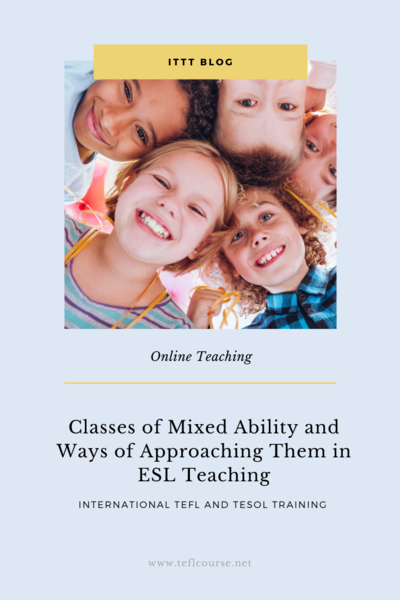How to Teach ESL Classes of Mixed Ability

Students are never on the same proficiency as one another. Whether that would be in Math class, Science class, or English class. Everyone has their own abilities and own knowledge. As a teacher, this can be an exciting challenge. There are many ways that you can improve learning in your mixed-ability classroom.
Table of Contents
Do you want to teach English abroad? Take a TEFL course!
This post was written by our TEFL certification graduate Bevan S. Please note that this blog post might not necessarily represent the beliefs or opinions of ITTT.
Peer Learning in Small Groups
One way to do this would be to pair the more proficient students with the less proficient students for an activity or two. Another thing a teacher could do would be to create an activity where the class is forced to move around and discuss with different peers, that way they can work together with people who are close to their level, and also get help from the more advanced students.
I remember that my Advanced Placement Japanese class was a very mixed level class. We had some kids who had skipped Japanese level 2 altogether, and some that were native speakers. My teacher often used the methods I had previously stated, and I plan to implement something like these activities into my lessons. At the beginning of this class, I had been very behind because I was a self-study student, so the teacher often paired me with more advanced students. With their help, I was able to get better and better and by the end of the year, the teacher was pairing me with the less advanced students so that I could help them.

These methods work. I love the fact that having a mixed class also allows a teacher to give more time for peers to discuss. The teacher has to make sure it is all in English, but it is a great way to build kinship inside of the classroom and give students time to talk. I believe it is very important that no matter what level a student may be, they should have a turn to talk. The more advanced students can teach the less advanced students by having the less advanced students listen and think about what the more advanced students are trying to communicate. Having a mixed ability class also does have its disadvantages. It can be hard to find general lessons to teach at times, and it can also be difficult not to focus too much on the less advanced students.
Also Read: "Is It Normal To Praise Students?"
Challenge
One must always make sure the students stay on topic. That would be the case for any class. A teacher must also provide challenging material for the advanced students so that they can keep growing as well. I remember my Japanese teacher had the advanced students learn kanji to better prepare them for the test at the end of the year. They often had more difficult and more assignments than the rest of the class.
That is just the way of a mixed level class though. There must be general assignments, advanced assignments, and beginning assignments. This can pose difficulty for the teacher at times. However, I would say that the pros outweigh the cons. Mixed classes can be superbly beneficial to students inside the classroom.
Do you want to teach English abroad? Take a TEFL course!
Apply now & get certified to teach english abroad!
Speak with an ITTT advisor today to put together your personal plan for teaching English abroad.
Send us an email or call us toll-free at 1-800-490-0531 to speak with an ITTT advisor today.
Related Articles:
- 7 Fun Activities for Teaching Vocabulary in the ESL Classroom
- 10 Questions You Need to Ask Before Enrolling In a TEFL Course
- Teaching English In China - The Salary and Budget Guide
- Online or In-Class - Which TEFL Course Should You Take?
- Teaching English Abroad: What's Next? - How To Advance In Your EFL Career




